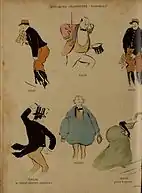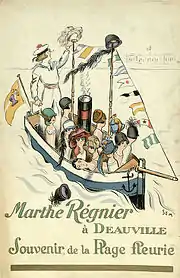Sem (artist)
Georges Goursat (23 November 1863[3] – 26 November 1934[2]), known as Sem, was a French caricaturist famous during the Belle Époque.
Georges Goursat | |
|---|---|
 | |
| Born | 23 November 1863[1] |
| Died | 26 November 1934[2] |
| Nationality | French |
| Other names | Sem |
| Occupation | artist |
| Known for | caricatures, posters |
Life and works
Youth (1863–1900)




Georges Goursat was born and raised in an upper-middle-class family from Périgueux.[4] The wealth inherited from his father at the age of 21[5] allowed him to sustain a gilded youth.[6]
In 1888 he self-published his first three albums of caricatures in Périgueux, signing some as "SEM",[7] allegedly as a tribute[8] to Amédée de Noé who signed his caricatures for Le Monde illustré as "Cham".[9]
He settled in Bordeaux from 1890 to 1898.[10] During this period, he published more albums and his first press caricatures in La Petite Gironde[11] and discovered the work of Leonetto Cappiello.[12] His style matured, becoming both simpler and more precise.[13]
During the same period, he made trips to Paris. In 1891, he designed two posters printed in Jules Chéret's workshop for the singer Paulus.[12] He published his first caricatures of artists in L'Illustration (Albert Brasseur) and Le Rire (Paulus, Polin and Yvette Guilbert[i. 1]).[12]
Goursat lived in Marseille from 1898 to 1900,[14][i. 2] where he met Jean Lorrain who convinced him to live in Paris.[15]

Belle Époque (1900–1914)
Goursat arrived in Paris in March 1900 at the time of the Universal Exposition opening.[16]
He chose horse racing[i. 3] as a way to enter high society.[16] In June 1900 he self-published his new album Le Turf of caricatures of many prominent Parisian socialites, including Marquess Boni de Castellane, Prince Trubetskoy, Count Clermont-Tonnerre, Baron Alphonse, Gustave de Rothschild, and Polaire.[16] The album's success made him famous overnight.[17] In October 1900 he published the album Paris-Trouville with equal success. Goursat published nine other albums before 1913.[18]
In 1904, Goursat received the Légion d'honneur.[19] In 1909, he exhibited with the painter Auguste Roubille, first in Paris and then in Monte Carlo and London. The exhibit included a diorama composed of hundreds of wooden figurines "of all the merely Paris celebrities".[20]
World War I (1914–1918)
Goursat was not drafted in World War I as he was over 50 years old at the start of the war.[21] He nevertheless involved himself as a war correspondent for Le Journal.[21] Some of his rather "chauvinistic" articles had an "enormous impact".[22] Ten articles were published in 1917 in Un pékin sur le front. Two other articles were incorporated in the 1923 book La Ronde de Nuit.[23] In 1916 and 1918 Goursat published two albums of Croquis de Guerre (War Sketches) with a completely different style than his previous work.[22] He also designed war bond posters.[24]
Années Folles (1918–1934)
After the war, Goursat returned to the kind of caricatures that made him famous. In 1919, he published Le Grand Monde à l'envers (High Society Upside Down).[25] Around 1923, he published three albums under the general title of Le Nouveau Monde (transl. The New World).[26] In 1923, he became an officer of the Légion d'honneur.[27]
In 1929, he was severely impoverished by the economic crisis.[28] After a heart attack in 1933,[29] he died in 1934.[2]
Personalities caricatured by Goursat
References
- (Bonnelle & Meneret 1979, p. 13)
- (Bonnelle & Meneret 1979, p. 171)
- (Bonnelle & Meneret 1979, p. 13)
- (Bonnelle & Meneret 1979, p. 14)
- (Bonnelle & Meneret 1979, p. 18)
- (Bonnelle & Meneret 1979, p. 19)
- (Bonnelle & Meneret 1979, pp. 21–23)
- Dixmier, Michel (2007). Quand le crayon attaque: images satiriques et opinion publique en France, 1814–1918 (in French). Autrement. p. 167. ISBN 978-2-7467-1052-8.
- Guerrand, Roger-Henri. "SEM Georges Goursat dit (1863–1934)" (in French). Encyclopaedia Universalis. Retrieved 3 September 2011.
- (Bonnelle & Meneret 1979, pp. 25–33)
- (Bonnelle & Meneret 1979, p. 25)
- (Bonnelle & Meneret 1979, pp. 30–33)
- (Bonnelle & Meneret 1979, p. 26)
- (Bonnelle & Meneret 1979, p. 35)
- (Bonnelle & Meneret 1979, p. 41)
- (Bonnelle & Meneret 1979, p. 45)
- (Bonnelle & Meneret 1979, p. 46)
- "La Belle Époque". Association Sem. Archived from the original on 20 February 2012. Retrieved 4 September 2011.
- "Bloc-notes parisien". Le Gaulois (in French). 15 August 1904.
- Pollard, Percival (1911). Vagabond Journeys: The Human Comedy at Home and Abroad. p. 42.
- (Bonnelle & Meneret 1979, p. 100)
- (Bonnelle & Meneret 1979, p. 112)
- (Bonnelle & Meneret 1979, p. 102)
- (Bonnelle & Meneret 1979, p. 116)
- (Bonnelle & Meneret 1979, p. 121)
- (Bonnelle & Meneret 1979, p. 123)
- (Bonnelle & Meneret 1979, p. 130)
- (Bonnelle & Meneret 1979, p. 136)
- (Bonnelle & Meneret 1979, p. 170)
Images
- Base Joconde: Les demi-vieilles, French Ministry of Culture. (in French)
- Goursat, Georges. "Le port de Marseille" (in French). Réunion des Musées Nationaux. Retrieved 4 September 2011.
- Flameng, François; Vizzavona, François Antoine (1913). "Portrait de M. Sem, souvenir d'Ascot" (in French). Réunion des Musées Nationaux.
Bibliography
- Bonnelle, Madeleine; Meneret, Marie-José (1979). SEM (in French). Périgueux: Pierre Fanlac. ISBN 2-86577-144-X.
- Dini, Francesca (2006). Boldini, Helleu, Sem : protagonisti e miti della Belle Epoque (in Italian). Skira.













_-_Robert_de_Montesquiou_(1891).jpg.webp)









